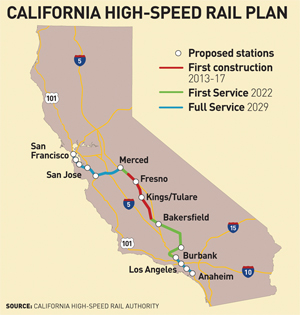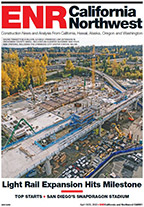
The money is already starting to move to firms like AECOM and Tutor Perini following a California budget resolution earlier this summer that cleared the way for a continuous, year-over-year, funding stream for the state’s ambitious high-speed rail project. Top engineering and construction firms—likely to be called upon to build, and also finance the project—have been waiting for long-term public funding commitments before risking their own capital and labor, says Stephen Polechronis, senior vice president of AECOM, which provided some of the earliest design and planning services for the rail line.
Industrial polluters will be imposed upon by AB 32, the California Global Warming Solutions Act of 2006, to fund construction over the next 20 years—$250 million in fiscal 2014 and 25% of the revenues of the market-based emissions cap-and-trade program annually. “We and other teams are at work today moving forward on the state and federal environmental studies necessary to get the construction permits,” Polechronis says.
AECOM also has been able to increase the pace of its design and engineering work on the central base of operations near Fresno, since the cap-and-trade funding mechanism was included in the state budget and ratified in June. A Tutor Perini-led team has started physical work on the project’s first design-build contract, worth nearly $1 billion, in the Salinas Valley.
Hotly contested legal challenges to the project’s pathway and finances remain. Dubbed the “Train to Nowhere” by opponents, the 521-mile, $68-billion project has been controversial from its earliest stages of development. Just a week after the budget resolution was approved, giving the California Air Resources Board the power to direct revenues from its carbon emissions cap-and-trade program to high speed rail, a lawsuit was filed to stop it. The Transportation Solutions and Education Fund, which filed the suit in Fresno District Court, says the train will not help California meet its greenhouse-gas emissions reduction targets included in AB 32, and therefore should not receive funding from GHG tax revenues.
Other funds are tied up with legal challenges too. Voters approved $8.6 billion in bond sales to finance the project in 2008, but those funds have languished as yet another court challenge in Sacramento prevented the sale and distribution of the bonds. “Proponents only approved that money if funding was secured from other sources, they didn’t want to spend $10 billion on this project and run out of money halfway through,” Polechronis says. “That’s what’s being worked out in the court … if the state has a comprehensive funding plan that can complete the project. But that money is there, the voters in the state of California want this project.”
The California High Speed Rail Authority says it’s confident that money will eventually make its way to the project. “We can’t sell bonds until this litigation is behind us,” says Lisa Alley, spokeswoman for HSRA. “We hope the appeals decision frees some of that money up.”
Further, Polechronis is not optimistic about federal funding for the project at to continue. Republicans in Washington have vowed to kill the project, which has become a stage for a political showdown between California Gov. Jerry Brown (D) and new House Majority leader Rep. Kevin McCarthy (R-Calif.), who said in a statement, “As long as I am in Congress, I will do whatever I can to ensure that not one dollar of federal funds is directed to this project.” McCarthy said the project will strain the budget, disrupt local communities and hurt taxpayers.
AECOM acknowledged Congress’ unwillingness to provide additional funding on the project since California high-speed rail development received grants from the American Recovery and Reinvestment Act of 2008. “It slowed things down,” Polechronis says.
With political, legal and financial risks looming, contractors nevertheless consider the continuous stream of cap-and-trade funding very good insurance against risking their own capital to help build the high speed line. “It underscores the attractiveness of a public works project not subject to annual funding appropriation requirements,” Polechronis says. “Going from government to government frightens us away. When there is a 20-year agreement, then you feel that there is a real partnership from the public sector.”
Partnership is key as major contracts awarded on this project will surely be structured as P3 contracts, Polechronis says. Many designers, engineers and contractors will assume partnering roles through a series of manageable contracts, he adds, which may represent a delicate task as interface risks are introduced. “Delivery, operation, integration, resource and stakeholder management will be major risks,” Polechronis says. “From a technical standpoint, the next project to be bid is a big dirt job.”
Ultimately, contractors’ recent expression of commitment not only to build but also to invest proves high-speed rail is viable in California, Alley says. “The long-term revenue stream really revitalized interest from the public sector and more contractors have been coming forward in support of the project, contractors with experience in high speed rail. … We know it can be done,” she says. “This is the first high-speed rail corridor in the United States, but it’s not the first in the world.”



Post a comment to this article
Report Abusive Comment